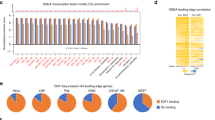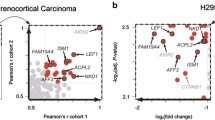Abstract
Background: MicroRNA are involved in the pathogenesis of several tumors, and several studies have been performed on the microRNA profile of adrenocortical tumors to date. The pathways affected by these microRNA, however, have not been analyzed yet by a systematic approach. Aim: To perform an in silico bioinformatics analysis of microRNA commonly altered in at least two studies and to decipher the pathways affected by microRNA in adrenocortical tumors. Methods: Datasets on microRNA and mRNA expression have been retrieved from 5 and 3 studies, respectively. MicroRNA mRNA targets have been identified by our tissue specific target prediction pipeline, and mRNA have been subjected to Ingenuity Pathway Analysis. Results: Thirty-nine microRNA were identified as commonly altered in two studies. Altogether 49, 817 mRNA targets have been found for these microRNA. One-hundred and seventy-eight significant pathways associating with these have been identified and were found in all studies. We have selected 12 pathways involving retinoic acid signaling (lipopolysaccharide/interleukin-1 mediated inhibition of retinoic X receptor (RXR) function, peroxisome proliferator-activated receptor (PPAR)α/RXRα activation, retinoic A receptor activation and PPAR signaling pathways) and cell cycle alterations (aryl hydrocarbon receptor signaling, growth arrest and DNA damage-inducible 45 signaling, integrin signaling, G2/M DNA damage checkpoint regulation, cyclins and cell cycle regulation and cell cycle control of chromosomal replication pathways) as these have been also established in our previous study on the functional genomics meta-analysis of adrenocortical tumors. Several microRNA have been identified that could affect these pathways. Conclusions: MicroRNA might affect several pathogenic pathways in adrenocortical tumors. Validation studies are required to confirm the biological relevance of these findings.
Similar content being viewed by others
References
Koch CA, Pacak K, Chrousos GP. The molecular pathogenesis of hereditary and sporadic adrenocortical and adrenomedullary tumors. J Clin Endocrinol Metab 2002, 87: 5367–84.
Soon PS, McDonald KL, Robinson BG, Sidhu SB. Molecular markers and the pathogenesis of adrenocortical cancer. Oncologist 2008, 13: 548–61.
Fassnacht M, Libé R, Kroiss M, Allolio B. Adrenocortical carcinoma: a clinician’s update. Nat Rev Endocrinol 2011, 7: 323–35.
Stahlhut Espinosa CE, Slack FJ. The role of microRNAs in cancer. Yale J Biol Med 2006, 79: 131–40.
Baek D, Villén J, Shin C, Camargo FD, Gygi SP, Bartel DP. The impact of microRNAs on protein output. Nature 2008, 455: 64–71.
Selbach M, Schwanhäusser B, Thierfelder N, Fang Z, Khanin R, Rajewsky N. Widespread changes in protein synthesis induced by microRNAs. Nature 2008, 455: 58–63.
Lionetti M, Agnelli L, Lombardi L, Tassone P, Neri A. MicroRNAs in the pathobiology of multiple myeloma. Curr Cancer Drug Targets 2012, 12: 823–37.
Lee RC, Ambros V. An extensive class of small RNAs in Caenorhabditis elegans. Science 2001, 294: 862–64.
Chen CZ. MicroRNAs as oncogenes and tumor suppressors. N Engl J Med 2005, 353: 1768–71.
Cimmino A, Calin GA, Fabbri M, et al. miR-15 and miR-16 induce apoptosis by targeting BCL2. Proc Natl Acad Sci USA 2005, 102: 13944–9.
Vreugdenhil E, Verissimo CS, Mariman R, et al. MicroRNA 18 and 124a down-regulate the glucocorticoid receptor: implications for glucocorticoid responsiveness in the brain. Endocrinology 2009, 150: 2220–8.
Ventura A, Jacks T. MicroRNAs and cancer: short RNAs go a long way. Cell 2009, 136: 586–91.
Wijnhoven BP, Michael MZ, Watson DI. MicroRNAs and cancer. Br J Surg 2007, 94: 23–30.
Bottoni A, Zatelli MC, Ferracin M, et al. Identification of differentially expressed microRNAs by microarray: a possible role for microRNA genes in pituitary adenomas. J Cell Physiol 2007, 210: 370–7.
Roldo C, Missiaglia E, Hagan JP, et al. MicroRNA expression abnormalities in pancreatic endocrine and acinar tumors are associated with distinctive pathologic features and clinical behavior. J Clin Oncol 2006, 24: 4677–84.
Weber F, Teresi RE, Broelsch CE, Frilling A, Eng C. A limited set of human MicroRNA is deregulated in follicular thyroid carcinoma. J Clin Endocrinol Metab 2006, 91: 3584–91.
Tömböl Z, Szabó PM, Molnár V, et al. Integrative molecular bioinformatics study of human adrenocortical tumors: microRNA, tissue-specific target prediction, and pathway analysis. Endocr Relat Cancer 2009, 16: 895–906.
Soon PS, Tacon LJ, Gill AJ, et al. miR-195 and miR-483-5p Identified as Predictors of Poor Prognosis in Adrenocortical Cancer. Clin Cancer Res 2009, 15: 7684–92.
Patterson EE, Holloway AK, Weng J, Fojo T, Kebebew E. MicroRNA profiling of adrenocortical tumors reveals miR-483 as a marker of malignancy. Cancer 2011, 117: 1630–9.
Schmitz KJ, Helwig J, Bertram S, et al. Differential expression of microRNA-675, microRNA-139-3p and microRNA-335 in benign and malignant adrenocortical tumours. J Clin Pathol 2011, 64: 529–35.
Özata DM, Caramuta S, Velázquez-Fernández D, et al. The role of microRNA deregulation in the pathogenesis of adrenocortical carcinoma. Endocr Relat Cancer 2011, 18: 643–55.
Singh P, Soon PS, Feige JJ, et al. Dysregulation of microRNAs in adrenocortical tumors. Mol Cell Endocrinol 2012, 351: 118–28.
Szabó PM, Butz H, Igaz P, Rácz K, Hunyady L, Patócs A. Including microRNAs into “omics”-based networks: a potential novel approach for modeling endocrine diseases (MiRomics in endocrinology). Mol Endocrinol 2013, 27: 573–85.
de Reyniès A, Assié G, Rickman DS, et al. Gene expression profiling reveals a new classification of adrenocortical tumors and identifies molecular predictors of malignancy and survival. J Clin Oncol 2009, 27: 1108–15.
Giordano TJ, Kuick R, Else T, et al. Molecular classification and prognostication of adrenocortical tumors by transcriptome profiling. Clin Cancer Res 2009, 15: 668–76.
Subramanian A, Tamayo P, Mootha VK, et al. Gene set enrichment analysis: a knowledge-based approach for interpreting genome-wide expression profiles. Proceedings of the National Academy of Sciences USA 2005, 102: 15545–50.
Szabó PM, Tamási V, Molnár V, et al. Meta-analysis of adrenocortical tumour genomics data: novel pathogenic pathways revealed. Oncogene 2010, 29: 3163–72.
Wen X, Li Y, Hu K, Dai C, Liu Y. Hepatocyte growth factor receptor signaling mediates the anti-fibrotic action of 9-cis-retinoic acid in glomerular mesangial cells. Am J Pathol 2005, 167: 947–57.
Ferré P. The biology of peroxisome proliferator-activated receptors: relationship with lipid metabolism and insulin sensitivity. Diabetes 2004, 53(Suppl 1): 43–50.
Betz MJ, Shapiro I, Fassnacht M, Hahner S, Reincke M, Beuschlein F. Peroxisome proliferator-activated receptor-γ agonists suppress adrenocortical tumor cell proliferation and induce differentiation. J Clin Endocrinol Metab 2005, 90: 3886–96.
Ferruzzi P, Ceni E, Tarocchi M, et al. Thiazolidinediones inhibit growth and invasiveness of the human adrenocortical cancer cell line H295R. J Clin Endocrinol Metab 2005, 90: 1332–9.
Chen Y, Stallings RL. Differential patterns of microRNA expression in neuroblastoma are correlated with prognosis, differentiation, and apoptosis. Cancer Res 2007, 67: 976–83.
Saumet A, Vetter G, Bouttier M, et al. Estrogen and retinoic acid antagonistically regulate several microRNA genes to control aerobic glycolysis in breast cancer cells. Mol Biosyst 2012, 8: 3242–53.
Zhao JJ, Yang J, Lin J, et al. Identification of miRNAs associated with tumorigenesis of retinoblastoma by miRNA microarray analysis. Childs Nerv Syst 2009, 25: 13–20.
Tong JL, Zhang CP, Nie F, et al. MicroRNA 506 regulates expression of PPAR alpha in hydroxycamptothecin-resistant human colon cancer cells. FEBS Lett 2011, 585: 3560–8.
Romao JM, Jin W, Dodson MV, Hausman GJ, Moore SS, Guan LL. MicroRNA regulation in mammalian adipogenesis. Exp Biol Med 2011, 236: 997–1004.
Kent OA, Mullendore M, Wentzel EA, et al. A resource for analysis of microRNA expression and function in pancreatic ductal adenocarcinoma cells. Cancer Biol Ther 2009, 8: 2013–24.
Rachagani S, Kumar S, Batra SK. MicroRNA in pancreatic cancer: pathological, diagnostic and therapeutic implications. Cancer Lett 2010, 292: 8–16.
Garzon R, Pichiorri F, Palumbo T, et al. MicroRNA gene expression during retinoic acid-induced differentiation of human acute promyelocytic leukemia. Oncogene 2007, 26: 4148–57.
Puga A, Marlowe J, Barnes S, et al. Role of the aryl hydrocarbon receptor in cell cycle regulation. Toxicology 2002, 182: 171–7.
Barouki R, Coumoul X, Fernandez-Salguero PM. The aryl hydrocarbon receptor, more than a xenobiotic-interacting protein. FEBS Lett 2007, 581: 3608–15.
Liebermann DA, Tront JS, Sha X, et al. Gadd45 stress sensors in malignancy and leukemia. Crit Rev Oncog 2011, 16: 129–40.
Augoff K, Das M, Bialkowska K, McCue B, Plow EF, Sossey-Alaoui K. miR-31 is a broad regulator of β1-integrin expression and function in cancer cells. Mol Cancer Res 2011, 9: 1500–8.
Penna E, Orso F, Cimino D, et al. microRNA-214 contributes to melanoma tumour progression through suppression of TFAP2C. EMBO J 2011, 30: 1990–2007.
Oneyama C, Morii E, Okuzaki D, et al. MicroRNA-mediated upregulation of integrin-linked kinase promotes Src-induced tumor progression. Oncogene 2012, 31: 1623–35.
Huang L, Luo J, Cai Q, et al. MicroRNA-125b suppresses the development of bladder cancer by targeting E2F3. Int J Cancer 2011, 128: 1758–69.
Legesse-Miller A, Elemento O, Pfau SJ, Forman JJ, Tavazoie S, Coller HA. let-7 overexpression leads to an increased fraction of cells in G2/M, direct down-regulation of Cdc34, and stabilization of Wee1 kinase in primary fibroblasts. J Biol Chem 2009, 284: 6605–9.
Liu C, Kelnar K, Vlassov AV, Brown D, Wang J, Tang DG. Distinct microRNA expression profiles in prostate cancer stem/progenitor cells and tumor-suppressive functions of let-7. Cancer Res 2012, 72: 3393–404.
Jia HY, Wang YX, Yan WT, et al. MicroRNA-125b Functions as a Tumor Suppressor in Hepatocellular Carcinoma Cells. Int J Mol Sci 2012, 13: 8762–74.
Zhang Y, Yan LX, Wu QN, et al. miR-125b is methylated and functions as a tumor suppressor by regulating the ETS1 proto-oncogene in human invasive breast cancer. Cancer Res 2011, 71: 3552–62.
Lin KY, Zhang XJ, Feng DD, et al. miR-125b, a target of CDX2, regulates cell differentiation through repression of the core binding factor in hematopoietic malignancies. J Biol Chem 2011, 286: 38253–63.
Duan Z, Choy E, Harmon D, et al. MicroRNA-199a-3p is downregulated in human osteosarcoma and regulates cell proliferation and migration. Mol Cancer Ther 2011, 10: 1337–45.
Shen L, Li J, Xu L, et al. miR-497 induces apoptosis of breast cancer cells by targeting Bcl-w. Exp Ther Med 2012, 3: 475–80.
Author information
Authors and Affiliations
Corresponding author
Additional information
Supplementary Figures and Tables are available in the electronic version.
Rights and permissions
About this article
Cite this article
Zsippai, A., Szabó, P.M., Szabó, D.R. et al. In silico analysis of pathways affected by differentially expressed microRNA in adrenocortical tumors. J Endocrinol Invest 36, 1011–1019 (2013). https://doi.org/10.3275/9024
Accepted:
Published:
Issue Date:
DOI: https://doi.org/10.3275/9024




